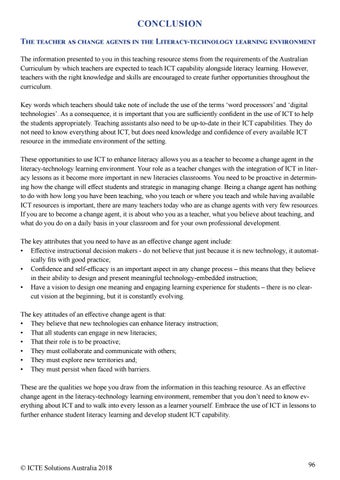CONCLUSION The teacher as change agents in the Literacy-technology learning environment The information presented to you in this teaching resource stems from the requirements of the Australian Curriculum by which teachers are expected to teach ICT capability alongside literacy learning. However, teachers with the right knowledge and skills are encouraged to create further opportunities throughout the curriculum. Key words which teachers should take note of include the use of the terms ‘word processors’ and ‘digital technologies’. As a consequence, it is important that you are sufficiently confident in the use of ICT to help the students appropriately. Teaching assistants also need to be up-to-date in their ICT capabilities. They do not need to know everything about ICT, but does need knowledge and confidence of every available ICT resource in the immediate environment of the setting. These opportunities to use ICT to enhance literacy allows you as a teacher to become a change agent in the literacy-technology learning environment. Your role as a teacher changes with the integration of ICT in literacy lessons as it become more important in new literacies classrooms. You need to be proactive in determining how the change will effect students and strategic in managing change. Being a change agent has nothing to do with how long you have been teaching, who you teach or where you teach and while having available ICT resources is important, there are many teachers today who are as change agents with very few resources. If you are to become a change agent, it is about who you as a teacher, what you believe about teaching, and what do you do on a daily basis in your classroom and for your own professional development. The key attributes that you need to have as an effective change agent include: • Effective instructional decision makers - do not believe that just because it is new technology, it automatically fits with good practice; • Confidence and self-efficacy is an important aspect in any change process – this means that they believe in their ability to design and present meaningful technology-embedded instruction; • Have a vision to design one meaning and engaging learning experience for students – there is no clearcut vision at the beginning, but it is constantly evolving. The key attitudes of an effective change agent is that: • They believe that new technologies can enhance literacy instruction; • That all students can engage in new literacies; • That their role is to be proactive; • They must collaborate and communicate with others; • They must explore new territories and; • They must persist when faced with barriers. These are the qualities we hope you draw from the information in this teaching resource. As an effective change agent in the literacy-technology learning environment, remember that you don’t need to know everything about ICT and to walk into every lesson as a learner yourself. Embrace the use of ICT in lessons to further enhance student literacy learning and develop student ICT capability.
© ICTE Solutions Australia 2018
96


